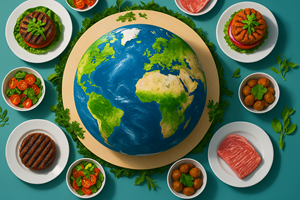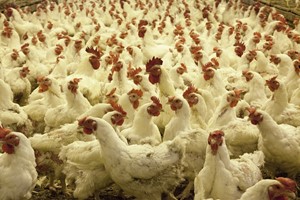The global food system stands at a critical crossroads. With nearly 30% of global greenhouse gas emissions attributed to food production, distribution, and consumption, the urgency to transition toward sustainable food systems has never been greater. The 2025 EAT-Lancet Commission report, released earlier this year, offers a comprehensive scientific roadmap for transforming food systems to meet climate goals, improve public health, and ensure food security for future generations.
The Climate-Food Nexus
Food systems are intricately linked to climate change. Agriculture alone contributes approximately 11% of global emissions, while land-use changes, food processing, transportation, and waste add significantly to the total. According to the EAT-Lancet Commission, without intervention, food-related emissions could increase by 40% by 2050, undermining efforts to limit global warming to 1.5°C.
The report emphasizes that business as usual is no longer viable. A transformation is needed across the entire value chain—from farms to fork—to reduce emissions, protect ecosystems, and promote equitable access to nutritious food.
Key Levers for Transformation
Dietary Shifts
Transitioning to healthier, plant-forward diets is one of the most impactful strategies. The report recommends reducing consumption of red meat and ultra-processed foods while increasing intake of legumes, whole grains, fruits, and vegetables. This shift could reduce diet-related emissions by up to 50%.
Sustainable Agriculture
Improving agricultural practices is essential. Techniques such as regenerative farming, precision agriculture, and agroecology can enhance soil health, reduce chemical inputs, and increase carbon sequestration. The report calls for scaling up innovations that boost productivity without expanding agricultural land.
Food Loss and Waste Reduction
Globally, nearly 30% of food produced is lost or wasted. Addressing inefficiencies in supply chains, improving storage infrastructure, and promoting consumer awareness can significantly lower emissions and improve resource use.
Halting Ecosystem Conversion
Deforestation and land conversion for agriculture are major drivers of biodiversity loss and emissions. Protecting forests, wetlands, and grasslands is critical to maintaining ecological balance and carbon sinks. These ecosystems also support countless species and provide essential services such as water filtration and climate regulation. Sustainable land management and restoration efforts are vital to reversing environmental degradation and ensuring long-term resilience.
Industry Implications and Opportunities
For food industry decision-makers, the transition to sustainable systems presents both challenges and opportunities:
• Innovation in Product Development: Companies can lead by developing low-carbon, plant-based alternatives and reformulating existing products to align with health and sustainability goals.
• Supply Chain Optimization: Investing in traceability, logistics efficiency, and local sourcing can reduce emissions and enhance resilience.
• Corporate Sustainability Commitments: Aligning with science-based targets and reporting frameworks (e.g., GHG Protocol, CDP) enhances transparency and stakeholder trust.
• Collaboration Across Sectors: Partnerships between agribusinesses, governments, NGOs, and academia are essential to scale solutions and share best practices.
Policy and Governance
The report stresses the need for coherent policy frameworks that incentivize sustainable practices. Key recommendations include:
• Subsidy Reforms: Redirect agricultural subsidies toward sustainable inputs and practices.
• Carbon Pricing: Implement mechanisms that reflect the true environmental cost of food production.
• Education and Awareness: Promote food literacy and sustainability education across all demographics.
Governments must also support research and innovation, particularly in climate-resilient crops, digital agriculture, and circular economy models.
Emerging Technologies Driving Change
Advances in technology offer promising solutions to accelerate the transition to sustainable food systems. Innovations such as vertical farming, lab-grown proteins, and digital platforms for supply chain transparency are reshaping how food is produced and distributed. These technologies increase efficiency, reduce environmental footprints, and can improve access to fresh and nutritious foods in urban and remote areas alike. Scaling these technologies require strategic investment and regulatory support to overcome barriers and ensure equitable benefits.
Empowering Smallholder Farmers
Smallholder farmers, who produce a significant share of the global food supply, are pivotal to achieving sustainability goals. The report highlights the importance of empowering these farmers through access to finance, climate-smart agricultural practices, and market integration. Strengthening farmer organizations and cooperatives can enhance bargaining power, improve livelihoods, and foster adoption of sustainable practices that contribute to climate resilience and food security.
Consumer Behavior and Market Demand
Shifts in consumer behavior are critical to drive demand for sustainable products. Transparency through labeling, certification schemes, and awareness campaigns can help consumers make informed choices that favor environmentally friendly and healthy foods. Retailers and food service providers have a key role in shaping market trends by prioritizing sustainable sourcing and promoting diversified diets that align with the EAT-Lancet recommendations.
Advancing Global Equity in Sustainable Food Systems
Achieving sustainable food systems must address global disparities in food access and nutrition. The roadmap calls for policies that tackle hunger and malnutrition while promoting sustainable production. This dual approach requires balancing productivity with social equity, ensuring marginalized communities benefit from sustainable innovations without exacerbating inequalities. Collaborative international efforts are essential to build resilient food systems that leave no one behind.
Conclusion
The transformation of food systems is not a distant ideal, it is a pressing necessity. The 2025 EAT-Lancet Commission provides a science-based blueprint for action, but success depends on collective commitment from industry leaders, policymakers, and consumers alike. For B2B stakeholders in the food industry, embracing sustainability is not only a moral imperative but a strategic advantage. By investing in innovation, transparency, and collaboration, companies can lead the way toward a future where food systems nourish both people and the planet.
- EAT-Lancet Commission Report 2025. https://eatforum.org/eat-lancet-commission
- Cornell University. “Sustainable Practices Could Cut Food-Related Emissions in Half.” MSN, October 3, 2025.
- UNEP & FAO. “UN Awards New World Restoration Flagships.” October 15, 2025.
- Sodexo. “Sodexo Champions Sustainable Eating at EAT Stockholm Food Forum.” Business Insider, October 13, 2025.
- FAO. “The State of Food and Agriculture 2023.” https://www.fao.org











